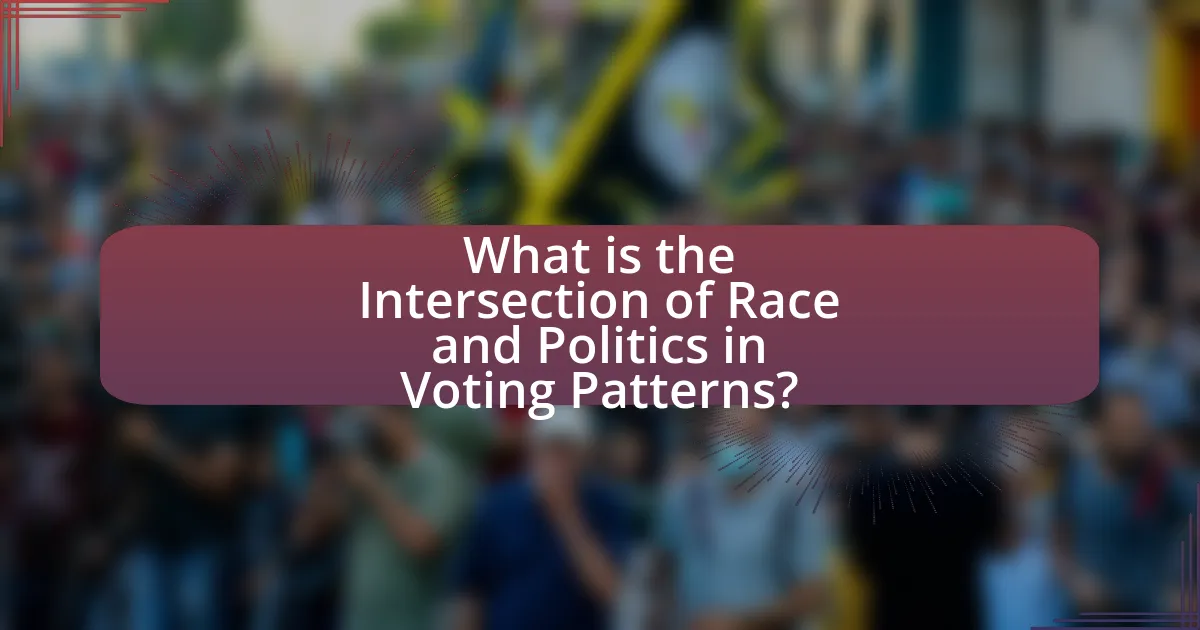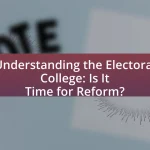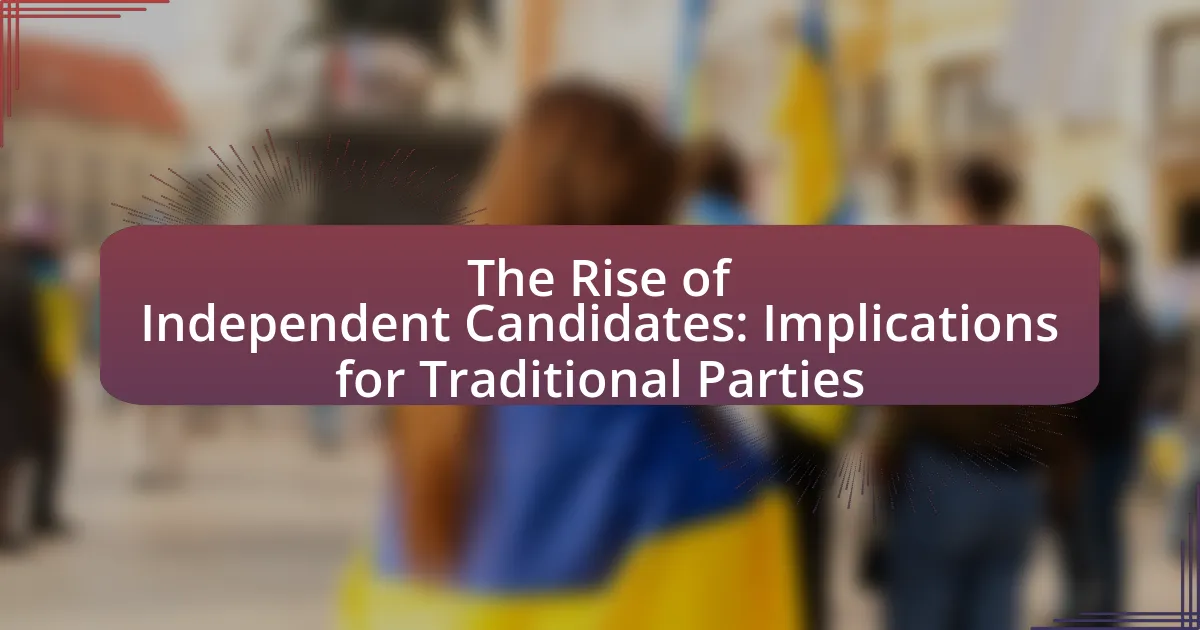The article examines the intersection of race and politics, specifically focusing on voting patterns among different racial groups in the United States. It highlights how racial identity influences political affiliation, turnout, and candidate preference, with significant disparities evident in recent elections, such as the 2020 presidential election. Key historical events, cultural factors, and systemic barriers like voter suppression are discussed to illustrate their impact on electoral behavior. The article emphasizes the importance of analyzing these patterns to understand electoral outcomes and improve political engagement among marginalized communities. Additionally, it explores methodologies for studying these trends and offers strategies for increasing voter participation among diverse racial groups.

What is the Intersection of Race and Politics in Voting Patterns?
The intersection of race and politics in voting patterns reveals significant disparities in electoral behavior among different racial groups. Research indicates that racial identity influences political affiliation, voting turnout, and candidate preference, with minority groups often aligning with specific parties that advocate for their interests. For instance, according to the U.S. Census Bureau, in the 2020 presidential election, 87% of Black voters supported the Democratic candidate, while 58% of White voters supported the Republican candidate. This trend highlights how race shapes political landscapes, as systemic factors such as socioeconomic status, historical disenfranchisement, and targeted voter suppression tactics further complicate these patterns.
How do race and politics influence voter behavior?
Race and politics significantly influence voter behavior by shaping individuals’ identities and perceptions of candidates. Research indicates that racial identity often correlates with political affiliation, as seen in the 2020 U.S. presidential election, where 87% of Black voters supported Joe Biden, reflecting a historical alignment with the Democratic Party that advocates for civil rights. Additionally, political rhetoric surrounding race can mobilize or demobilize voters; for instance, negative campaigning that targets racial groups can lead to increased turnout among those groups in opposition. Studies, such as those published in the American Political Science Review, demonstrate that voters are more likely to support candidates who they perceive as representing their racial interests, thus illustrating the intertwined nature of race and political behavior.
What historical events have shaped the relationship between race and voting?
The relationship between race and voting has been significantly shaped by events such as the Civil War, the Reconstruction Era, the Voting Rights Act of 1965, and various Supreme Court rulings. The Civil War led to the abolition of slavery and the subsequent Reconstruction Era, during which the 14th and 15th Amendments were ratified, granting citizenship and voting rights to African American men. However, the implementation of Jim Crow laws in the late 19th century systematically disenfranchised Black voters through literacy tests and poll taxes. The Voting Rights Act of 1965 aimed to eliminate these barriers, resulting in a substantial increase in Black voter registration and participation. Additionally, landmark Supreme Court cases, such as Shelby County v. Holder in 2013, have impacted voting rights by weakening federal oversight of state voting laws, leading to renewed challenges for racial minorities at the polls. These events collectively illustrate the ongoing struggle for equitable voting rights across racial lines in the United States.
How do cultural factors impact voting decisions among different racial groups?
Cultural factors significantly influence voting decisions among different racial groups by shaping their values, beliefs, and priorities. For instance, African American voters often prioritize social justice and civil rights, which can lead to strong support for candidates advocating for policies addressing systemic inequality. In contrast, Hispanic voters may focus on immigration reform and economic opportunities, reflecting cultural ties to family and community. Research from the Pew Research Center indicates that 70% of Black voters supported the Democratic Party in the 2020 election, driven by cultural factors such as historical disenfranchisement and community solidarity. Similarly, a study by the Center for American Progress found that 65% of Latino voters favored Democratic candidates, influenced by cultural emphasis on family and social welfare. These examples illustrate how cultural contexts shape the political preferences and voting behaviors of different racial groups.
Why is it important to analyze voting patterns through the lens of race?
Analyzing voting patterns through the lens of race is important because it reveals how racial demographics influence electoral outcomes and political representation. Understanding these patterns helps identify systemic inequalities and informs strategies to address voter disenfranchisement. For instance, studies show that racial minorities often face barriers such as voter ID laws and gerrymandering, which can skew representation. According to the U.S. Census Bureau, in the 2020 election, 61% of White voters participated compared to 50% of Black voters and 49% of Hispanic voters, highlighting disparities that can affect policy decisions and resource allocation. Thus, examining voting through a racial lens is crucial for fostering equitable political engagement and ensuring that all voices are represented in the democratic process.
What insights can be gained from understanding racial voting trends?
Understanding racial voting trends reveals significant insights into electoral behavior, political alignment, and social dynamics. These trends indicate how different racial and ethnic groups prioritize issues, influencing party platforms and campaign strategies. For instance, data from the 2020 U.S. Presidential Election showed that 87% of Black voters supported Joe Biden, while 58% of White voters supported Donald Trump, highlighting distinct preferences that can shape policy agendas. Additionally, analyzing these trends can uncover systemic inequalities and inform targeted outreach efforts, as seen in the increased mobilization of Latino voters in key states, which played a crucial role in the election outcomes. Understanding these patterns aids in predicting future electoral shifts and addressing the needs of diverse communities.
How do racial demographics affect electoral outcomes?
Racial demographics significantly influence electoral outcomes by shaping voting behaviors and preferences among different racial groups. For instance, in the 2020 U.S. presidential election, exit polls indicated that 87% of Black voters supported Joe Biden, while 58% of White voters favored Donald Trump, demonstrating a clear racial divide in voting patterns. Additionally, areas with higher concentrations of minority populations often see different electoral results compared to predominantly White areas, as candidates may tailor their messages to resonate with specific racial communities. This trend is supported by research from the Pew Research Center, which highlights how racial identity can impact political affiliation and voter turnout, ultimately affecting election results.
What methodologies are used to study the intersection of race and politics?
Quantitative and qualitative methodologies are used to study the intersection of race and politics. Quantitative methods often involve statistical analysis of voting patterns, demographic data, and survey results to identify trends and correlations between race and political behavior. For example, researchers may analyze data from the U.S. Census and voting records to assess how racial demographics influence electoral outcomes. Qualitative methods include interviews, focus groups, and ethnographic studies that provide deeper insights into the experiences and perceptions of racial groups regarding political participation. These methodologies are validated by studies such as “Racial and Ethnic Politics in America” by David L. Leal, which demonstrates how both quantitative and qualitative approaches can reveal the complexities of race in political contexts.
What data sources are most reliable for analyzing voting patterns?
The most reliable data sources for analyzing voting patterns include official election results, census data, and survey data from reputable organizations. Official election results, provided by state election offices, offer accurate counts of votes cast and demographic breakdowns. Census data, collected by the U.S. Census Bureau, provides essential demographic information that helps contextualize voting behavior across different racial and ethnic groups. Additionally, survey data from organizations like the Pew Research Center and Gallup can provide insights into voter attitudes and motivations, which are crucial for understanding voting patterns. These sources are validated through rigorous methodologies and are widely used in academic research and political analysis.
How do researchers account for biases in voting data?
Researchers account for biases in voting data by employing statistical techniques and methodologies that aim to identify and correct for discrepancies. They utilize methods such as stratified sampling, which ensures representation across different demographic groups, and weighting adjustments to balance the influence of underrepresented populations. For instance, studies often analyze historical voting patterns and demographic data to adjust for turnout discrepancies, ensuring that the data reflects the actual voting population. Additionally, researchers may conduct sensitivity analyses to assess how different assumptions about biases affect their findings, thereby enhancing the robustness of their conclusions.

What are the current trends in racial voting patterns?
Current trends in racial voting patterns indicate a growing polarization, with minority groups increasingly aligning with the Democratic Party while white voters show a tendency towards the Republican Party. For instance, in the 2020 presidential election, 87% of Black voters and 65% of Hispanic voters supported Joe Biden, reflecting a significant Democratic preference among these groups. In contrast, 57% of white voters backed Donald Trump, highlighting a stark division. This trend is supported by data from the Pew Research Center, which shows that racial and ethnic minorities are more likely to prioritize issues such as social justice and immigration reform, aligning them with Democratic policies. Additionally, younger voters of color are increasingly engaged in political activism, further solidifying these voting patterns.
How have recent elections reflected changes in racial voting behavior?
Recent elections have shown significant shifts in racial voting behavior, particularly with increased support for Democratic candidates among Black and Latino voters. For instance, the 2020 presidential election saw 87% of Black voters and 66% of Latino voters casting their ballots for Joe Biden, reflecting a notable increase in Democratic alignment compared to previous elections. This trend is supported by data from the Pew Research Center, which indicates that younger voters of color are increasingly prioritizing issues such as racial justice and climate change, influencing their voting preferences. Additionally, the 2022 midterm elections demonstrated continued engagement, with Black voter turnout reaching 51%, a 3% increase from 2018, highlighting a sustained commitment to political participation among these demographics.
What role do social movements play in shaping voting patterns among racial minorities?
Social movements significantly influence voting patterns among racial minorities by mobilizing communities, raising awareness of political issues, and advocating for policy changes. For instance, the Civil Rights Movement in the 1960s led to the Voting Rights Act of 1965, which aimed to eliminate barriers to voting for African Americans, resulting in increased voter registration and participation. Additionally, contemporary movements like Black Lives Matter have highlighted systemic injustices, encouraging younger generations of racial minorities to engage politically and vote. Research indicates that social movements can increase voter turnout by as much as 10% among targeted demographics, demonstrating their critical role in shaping electoral behavior.
How do voter suppression tactics affect different racial groups?
Voter suppression tactics disproportionately affect racial minority groups, particularly African Americans, Latinos, and Native Americans, by limiting their access to the electoral process. For instance, measures such as strict voter ID laws, purging of voter rolls, and reduced polling places often target areas with high concentrations of these populations, leading to longer wait times and increased difficulty in casting votes. According to a 2018 report by the Brennan Center for Justice, states with strict voter ID laws saw a significant drop in voter turnout among African American voters, with estimates indicating that up to 25% of eligible Black voters faced barriers due to these laws. Additionally, the U.S. Commission on Civil Rights found that minority voters are more likely to experience intimidation and misinformation at the polls, further exacerbating the impact of voter suppression tactics on their electoral participation.
What are the implications of these trends for future elections?
The implications of current voting trends for future elections indicate a potential shift in electoral outcomes, particularly as demographic changes influence voter behavior. For instance, increasing diversity in the electorate, as evidenced by the 2020 U.S. Census showing that minority groups accounted for over 50% of the population under 18, suggests that candidates may need to prioritize issues relevant to these communities to secure votes. Additionally, trends such as higher turnout rates among younger voters and minority groups, as seen in the 2020 presidential election where Black voter turnout increased by 2% compared to 2016, imply that future campaigns must engage these demographics more effectively. Consequently, political strategies will likely evolve to address the priorities of a more diverse electorate, impacting candidate selection, policy focus, and overall campaign approaches.
How might changing demographics influence political strategies?
Changing demographics significantly influence political strategies by shifting the priorities and messaging of political parties to align with the values and needs of emerging voter groups. For instance, as the population becomes more diverse, parties may focus on issues such as immigration reform, social justice, and healthcare access, which resonate more with younger and minority voters. According to the U.S. Census Bureau, by 2045, it is projected that the majority of the U.S. population will be composed of racial and ethnic minorities, prompting political candidates to adapt their platforms to appeal to these demographics. This adaptation can be seen in the increased emphasis on inclusive policies and outreach efforts aimed at underrepresented communities, which are crucial for electoral success in a changing electorate.
What potential shifts in party alignment can be anticipated?
Potential shifts in party alignment may include increased support for progressive policies among younger voters, leading to a realignment of traditional party bases. This trend is evidenced by the 2020 U.S. presidential election, where 61% of voters aged 18-29 supported the Democratic candidate, compared to 36% for the Republican candidate, indicating a significant generational divide. Additionally, demographic changes, such as the growing influence of Hispanic and Black voters, may push both parties to adapt their platforms to address issues like immigration reform and racial justice, further altering party dynamics.

How can understanding the intersection of race and politics improve electoral engagement?
Understanding the intersection of race and politics can significantly improve electoral engagement by addressing the unique barriers and motivations that different racial groups face in the political process. Research indicates that racial minorities often experience systemic disenfranchisement, which can lead to lower voter turnout. For example, the U.S. Census Bureau reported that in the 2020 election, Black and Hispanic voters had lower turnout rates compared to White voters, highlighting the need for targeted outreach and education efforts. By recognizing these disparities, political campaigns can tailor their messages and strategies to resonate with diverse communities, thereby fostering greater participation. Additionally, understanding the historical context of racial issues in politics, such as voter suppression tactics, can empower marginalized groups to engage more actively in the electoral process, ultimately leading to a more representative democracy.
What strategies can be employed to increase voter turnout among marginalized communities?
To increase voter turnout among marginalized communities, targeted outreach strategies must be employed. These strategies include community engagement initiatives, such as organizing local events that educate residents about the voting process and the importance of participation. Research indicates that when communities are directly involved in the electoral process through grassroots campaigns, voter turnout can increase significantly; for example, the 2018 midterm elections saw a 50% increase in turnout among young voters due to such initiatives. Additionally, providing resources like transportation to polling places and assistance with voter registration can further enhance participation rates. Data from the U.S. Census Bureau shows that logistical barriers are a major reason for low turnout in marginalized communities, highlighting the need for practical support.
How can political campaigns effectively address the concerns of diverse racial groups?
Political campaigns can effectively address the concerns of diverse racial groups by implementing targeted outreach strategies that prioritize engagement and representation. Campaigns should conduct thorough research to understand the specific issues faced by different racial communities, such as economic inequality, healthcare access, and criminal justice reform. For instance, a study by the Pew Research Center found that 70% of Black voters prioritize economic issues, while 60% of Hispanic voters emphasize immigration reform. By tailoring messages and policies to resonate with these priorities, campaigns can foster trust and support among these groups. Additionally, involving diverse voices in campaign leadership and decision-making processes ensures that the concerns of these communities are authentically represented, leading to more effective communication and policy proposals.
What role does education play in enhancing political participation among different races?
Education significantly enhances political participation among different races by increasing awareness of civic rights and responsibilities. Higher levels of education correlate with greater knowledge of political processes, leading to increased voter turnout and engagement in political discussions. For instance, a study by the U.S. Census Bureau indicates that individuals with a bachelor’s degree are more likely to vote than those with only a high school diploma, with a turnout rate of 73% compared to 53%. This trend is consistent across racial groups, suggesting that education serves as a critical factor in bridging participation gaps. Furthermore, educational institutions often provide platforms for civic engagement, fostering a sense of community and encouraging diverse racial groups to participate in the political landscape.
What best practices can be adopted for inclusive political outreach?
Best practices for inclusive political outreach include actively engaging diverse communities, utilizing multiple communication channels, and ensuring representation in decision-making processes. Engaging diverse communities involves organizing outreach events in various neighborhoods and collaborating with local organizations that represent different racial and ethnic groups. Utilizing multiple communication channels, such as social media, community radio, and multilingual materials, ensures that information reaches a broader audience. Ensuring representation in decision-making processes can be achieved by including individuals from underrepresented groups in campaign teams and advisory boards. These practices are supported by studies showing that inclusive outreach increases voter participation among marginalized communities, as evidenced by the increased turnout in areas where targeted outreach efforts were implemented during elections.
How can community organizations support voter registration efforts?
Community organizations can support voter registration efforts by conducting outreach programs that educate and inform residents about the registration process. These organizations often host events, such as workshops and informational sessions, to demystify the registration process and provide assistance with filling out forms. For instance, the National Association of Secretaries of State reported that community-led initiatives have significantly increased registration rates, particularly in underrepresented demographics. By leveraging local networks and resources, community organizations can effectively mobilize individuals to register and participate in elections, thereby enhancing civic engagement and representation.
What are effective methods for fostering dialogue on race and politics in communities?
Effective methods for fostering dialogue on race and politics in communities include organizing structured community forums, promoting educational workshops, and utilizing social media platforms for discussion. Community forums create safe spaces for individuals to share experiences and perspectives, which can lead to greater understanding and empathy. Educational workshops can provide participants with historical context and current issues related to race and politics, enhancing informed discussions. Social media platforms facilitate broader engagement and allow for diverse voices to contribute to the conversation, making it accessible to a wider audience. Research indicates that these methods can significantly improve community cohesion and understanding, as evidenced by initiatives like the “Race and Politics Dialogue Project,” which successfully engaged diverse groups in meaningful conversations.





